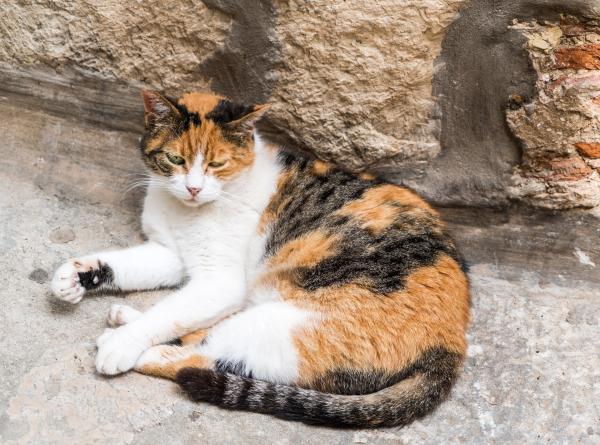Are There Male Calico Cats?



See files for Cats
Calico cats are appropriately named. Calico is a material which is easy to produce, but is also able to be dyed in many different colors for printing and clothing. Calico cats are a common variety which take different colors from their ancestors and combined them in a three colored coat. This can make for some of the most beautiful, if often erratic, combination colors of cat fur. These colors can present as patches, but tabby patterns such as stripes and swirls can also be part of their look.
Calico cats, however, are not a breed in and of themselves. In fact, these tricolor markings are found on a whole range of different breeds. You may have heard people point out all calico cats are female, but this isn't quite true. AnimalWised answers the question ‘are there male calico cats?’ so we can delve more deeply into these fascinatingly marked critters.
Difference between a calico cat and a tortoiseshell cat
The difference between a calico cat and a tortoiseshell cat is very slim. The genetic reasons behind their coloration is relatively similar, but the main variation is the white on a calico cat. Just as calico material is blank, calico cats are usually predominantly white. The patches and spots of color are often sparse and appear in sections on the feline's coat. However, some can have larger patches which cover more body area than the white fur.
The other two colors in a calico cat are most often orange and black. Tortoiseshell cats have a combination of orange and black, but very rarely have white on their coat. Tortoiseshell cats also more often have subtler color integration whereas the calico usually has larger patches, although not always.
If a calico cat gives birth to a litter, it doesn't mean their offspring will also be calico patterned. They can give birth to cats of solid color, have calico kittens with different patterns or have some combination of any. What is almost completely certain is that a calico patterned cat from a calico mother will not have the exact same pattern. The genetic probability for this to happen is so unlikely, it is practically impossible.
There are some breeds which allow for calico patterns more than others and they include:
- Siberian cat
- Turkish Angora
- British Shorthair
- American Shorthair
- Exotic Shorthair
- Persian
- Japanese Bobtail
The orange and black colors give these cats a beautiful tricolor coat when mixed with white. They are thought to have particular temperaments, but this is hard to argue as their temperament is more to do with their breed and upbringing. As we said before, a calico cat is not an actual breed, but a patterning which exists on different breeds. What we do know is that over 99% of all calico cats are female, but how come?

Genetics of a calico cat
If the overwhelming majority of calico cats are female, this must mean a very small minority are male. To answer the article question, there are indeed male calico cats. But why are there so few? The answer is in the genes.
All cells in the body of a cat will have two chromosomes, one which is dominant and one which is recessive. The gene which controls the color of the cat's body is in one of these genes. If the dominant chromosome is the one with, for example, black pigmentation, then the cat will be black. All the different cells in the body will lead to the color of the cat, but only in the area where those cells operate. This is how there come to be patches of color on a cat's coat. A male cat can have dominant black color in one area and dominant white in another, leading to patches of color. One of these patches, however, cannot be orange.
The lack of orange is because, if you are a female cat, you will have two X chromosomes. Having two X chromosomes which are active in the cell of a cat can be potentially dangerous. This is why female cat cells go through a process of ‘X inactivation’, also known as lyonization. This is when one of the X chromosomes is deactivated and the determining genes are found in the other.
Since the color of the cat is determined by the X chromosome, males will only have one dominant color. Females, however, have two c chromosomes which offers the possibility to have two colors at the same time. This is what leads to tortoiseshell cats, i.e. black and ginger cats. The white color doesn't come from piebalding, where the X chromosome has a dominant gene which produces no pigment at all. So a tricolored calico cat is almost always a female because it needs two X chromosomes to create the different colors, but some of these chromosomes might also be those with no pigmentation.
The only way a male cat can be a calico cat is if it has an extra X chromosome. If this is the case, then it is because of a genetic anomaly and will lead to a particular syndrome. Male cats with XXY chromosomes will likely have something called Klinefelter syndrome and, with only the very rarest of exceptions, will be sterile.
Why are calico cats so special?
There are two reasons why calico cats are special. Firstly, they are a genetic wonder. The above process is a complicated one which leads to these wonderful quirks of nature. Secondly, calico cats have a storied history. Their often incredibly coloration have made them noticeable in many different cultures. These cultures have sometimes ascribed certain characteristics which, while maybe not quite true, add something to their legacy. These include:
- They are the basis of the maneki-neko in Asian culture. The maneki-neko is a popular gold or white cat statue which is thought to provide luck for their owners. The traditional maneki-neko has ginger and black patches on white porcelain - exactly that of the calico cat.
- Japanese sailors would keep a calico ad the ship's cat as it was believed to bring them luck on their journey.
- They are thought by some to have originated in Egypt, meaning they were part of the rich culture of cat worshipping there in ancient times.
- In Irish folklore, there were believed to cure warts if you rubbed the tail of a calico during the month of may. Much grosser for the cat than anyone, it's success has little evidence to support it.
- Some even thought calico cats to be evil, but it was simply their enormous mystique had a reaction one way or the other.
If you want to read similar articles to Are There Male Calico Cats?, we recommend you visit our Facts about the animal kingdom category.






 I have taken in an abandoned cat and discovered it is definitely a male. Since it has 3 colors, I thought it was a female. Wrong! Would this be a calico or a calico tabby cat?
I have taken in an abandoned cat and discovered it is definitely a male. Since it has 3 colors, I thought it was a female. Wrong! Would this be a calico or a calico tabby cat?


 Here is our male calico "Qyle". Beautiful and sweet!! :)
Here is our male calico "Qyle". Beautiful and sweet!! :)

